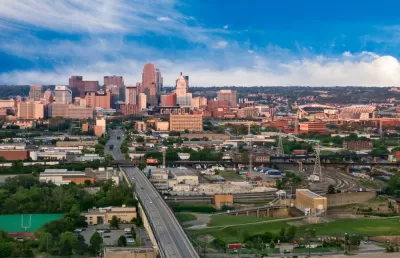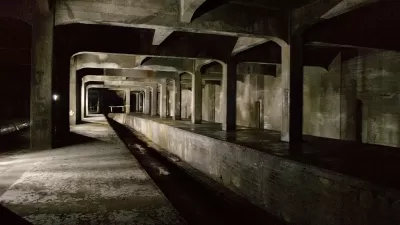A new study drives home the need for heat reduction measures in areas populated by lower-income residents.

A heat map produced by measuring temperatures across Cincinnati on August 10, 2020 bears a striking resemblance to maps of household income, neighborhood demographics, and the history of redlining, reports Danny Wicentowski. The findings of the study support the unfortunate reality that communities of color in the United States bear the brunt of climate change impacts.
The report, made possible by funding from the National Oceanic and Atmospheric Administration's Climate Program Office, "observed that large developments absorb and retain heat throughout the day, affecting even nearby residences," Wicentowski writes. The report further noted a commonality between the hottest areas: a notable lack of vegetation. Conversely, the coolest temperatures measured on that summer day were recorded in areas with ample tree-cover.
Wicentowski reminds readers that minimal tree canopy in lower-income areas is hardly a revelation and has even been noted in a 2018 version of the Green Cincinnati Plan. One of the plan's "major resiliency recommendations: increase the city’s tree canopy to shield communities from ever-increasing heat in the summer and to soak up water from those massive rainfall events."
According to a Cincinnati Parks press release, the data from the study will be used to prioritize areas of service to "implement targeted planting plans in communities with the greatest need."

Study: Maui’s Plan to Convert Vacation Rentals to Long-Term Housing Could Cause Nearly $1 Billion Economic Loss
The plan would reduce visitor accommodation by 25,% resulting in 1,900 jobs lost.

North Texas Transit Leaders Tout Benefits of TOD for Growing Region
At a summit focused on transit-oriented development, policymakers discussed how North Texas’ expanded light rail system can serve as a tool for economic growth.

Why Should We Subsidize Public Transportation?
Many public transit agencies face financial stress due to rising costs, declining fare revenue, and declining subsidies. Transit advocates must provide a strong business case for increasing public transit funding.

How to Make US Trains Faster
Changes to boarding platforms and a switch to electric trains could improve U.S. passenger rail service without the added cost of high-speed rail.

Columbia’s Revitalized ‘Loop’ Is a Hub for Local Entrepreneurs
A focus on small businesses is helping a commercial corridor in Columbia, Missouri thrive.

Invasive Insect Threatens Minnesota’s Ash Forests
The Emerald Ash Borer is a rapidly spreading invasive pest threatening Minnesota’s ash trees, and homeowners are encouraged to plant diverse replacement species, avoid moving ash firewood, and monitor for signs of infestation.
Urban Design for Planners 1: Software Tools
This six-course series explores essential urban design concepts using open source software and equips planners with the tools they need to participate fully in the urban design process.
Planning for Universal Design
Learn the tools for implementing Universal Design in planning regulations.
Ascent Environmental
Borough of Carlisle
Institute for Housing and Urban Development Studies (IHS)
City of Grandview
Harvard GSD Executive Education
Toledo-Lucas County Plan Commissions
Salt Lake City
NYU Wagner Graduate School of Public Service





























